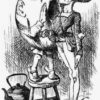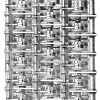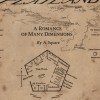
Jean Little, “Algebraic Logic in Through the Looking Glass”
This essay argues that Lewis Carroll’s Through the Looking Glass, which was published December 27, 1871, refers repeatedly to mathematics and logic in ways that, while certainly playful, reflect a careful thinking through of Boolean logic. Just as George Boole’s symbolic algebra relies on relational and oppositional binaries to create an internally coherent system, Through the Looking Glass experiments with binaries in their various forms, often using the numbers zero and one as placeholders for more complex ideas. This model of logic as a systematic grouping of concepts that could be represented numerically and visually would influence Carroll’s later work, culminating in Symbolic Logic (1896).

Roger Whitson, “The Difference Engine: 1832, 1855, 1876, 1991, 2002, 2008”
The difference engine is a case study in what media archaeologists see as a diversity of temporalities entangling the production and functionality of technological media. Only an unfinished prototype, what was called “Babbage’s beautiful fragment” existed of Babbage’s designs during his lifetime. Even so, many machinists created their own variations of the difference engine after Babbage’s death. This phenomenon, and the many troubles Babbage himself ran into regarding the materials used to create the difference engine, demonstrates that the machine’s functionality exceeded its inventor’s intentions and awareness.

Deanna Kreisel, “The Discovery of Hyperspace in Victorian Literature”
This article examines the discovery of non-Euclidean and higher-dimensional geometries in the latter part of the nineteenth century.

Anna Kornbluh, “Thomas Hardy’s ‘End of Prose,’ 1896”
This entry considers Thomas Hardy’s “End of Prose,” his renunciation of the novel in favor of poetry, as an important event in nineteenth-century literary history, motivated by aesthetic concerns. It reads the geometric imagery in Hardy’s final novel, Jude the Obscure, in connection with the advent of non-Euclidean geometry, suggesting that mathematical forms inspired Hardy’s turn to the poetic line.
